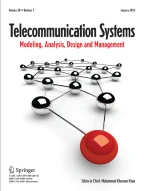Abstract
This study introduces a new low complexity Max-Log-MAP based channel estimation technique operating in a multi-path band limited channel. The proposed estimation technique is based on an iterative procedure derived through the maximum a posteriori probability approach. Wireless communication channels often undergo frequency selective fading that leads to inter-symbol interference, which limits the performance of wireless indoor systems. Performance of the algorithms is assessed by combined analysis and simulation. Results are presented and compared against the performance of conventional Log-MAP algorithm. The obtained results show that the required bit-error-rate performance can be achieved with a lower number of iterations using the proposed low complexity algorithm compared to using the conventional Log-MAP algorithm.
Similar content being viewed by others
Explore related subjects
Discover the latest articles, news and stories from top researchers in related subjects.References
Shafi, M., Ogose, S., & Hattori, T. (2002). Wireless communications in the 21st century. New York: Wiley.
Convery, S. (2007). Network authentication, authorization, and accounting—Part two: Protocols, applications, and the future of AAA, The Internet Protocol Journal 10(2).
Proakis, J. G. (2001). Digital communications (4th ed.). New York: McGraw-Hill.
Qureshi, S. (1985). Adaptive equalization. In Proceedings of IEEE (Vol. 73, no. 9, pp. 1349–1387).
Ziegler, R. A., Al-Dhahir, M. W., & Cioffi, J. M. (1992). Nonrecursive adaptive DFE from channel estimates. In Proc. IEEE vehicular technology conference (VTC) (Vol. 2, pp. 600–603). Denver Co, 10–13 May 1992.
Maguib, A. F., Tarokh, V., Seshadri, N., & Calderbank, A. R. (1998). Space-time coding modem for high-data-rate wireless communications. IEEE Journal on Selected Areas in Communications, 16(8), 1459–1478.
Cozzo, C., & Hughes, B. L. (2003). Joint channel estimation and data detection in space-time communications. IEEE Transactions on Communications, 51(8), 1266–1270.
Talakoub, S., Sabeti, L., Shahrrava, B., & Ahmadi, M. (2007). An improved Max-Log-MAP algorithm for turbo decoding and turbo equalization. IEEE Transaction on Instrumentation and Measurement, 56(3), 1058–1063.
Zhang, D., Liu, J., Yang, X., & Ji, H. (2008). Max-Log-MAP and Log-MAP decoding algorithms for UST symbol based turbo code. In The 4th international conference on wireless communications, networking and mobile computing (WiCOM 2008), China.
Papaharalabos, S., Sweeney, P., & Evans, B. G. (2007). SISO algorithms based on Max-Log-MAP and Log-MAP turbo decoding. IET Communications, 1(1), 49–54.
Giordana, A., & Hsu, F. (1985). Least square estimation with application to digital signal processing. New York: Wiley.
Deng, X., Haimovich, A. M., & Garcia-Frias, J. (2003). Decision directed iterative channel estimation for MIMO systems. In Proc. IEEE international conference on communication (ICC) (Vol. 4, pp. 2326–2329). Anchorage, AL, 11–15 May 2003.
Yan, M., & Rao, B. D. (2003). Soft decision-directed MAP estimate of fast Rayleigh flat fading channels. IEEE Transactions on Communications, 51(12), 1965–1969.
Summer, T. A., & Wilson, S. G. (1998). SNR mismatch and online estimation in turbo decoding. IEEE Transactions on Communications, 46(4), 421–423.
Jeng, L., Su, Y. T., & Chiang, J. T. (1998). Performance of turbo codes in multipath fading channel. In Proc. IEEE Veh. Tech. Conf. (pp. 61–65). Canada, May 1998.
Erfanian, J. A., Pasupathy, S., & Gulak, G. (1994). Reduced complexity symbol detectors with parallel structures for ISI channels. IEEE Transactions on Communications, 42, 1661–1671.
Benedetto, S., Divsalar, D., Montorsi, G., & Pollara, F. (1996). Soft-output decoding algorithms in iterative decoding of turbo codes (JPL TDA Progress Report 42–124), Feb. 15 (1996).
Kahveci, S., Kaya, I., & Türk, K. (2008). Dynamic Look-Up-Table-Based maximum a posterior probability algorithm. Wireless Personal Communications, 46(3), 317–328.
Author information
Authors and Affiliations
Corresponding author
Rights and permissions
About this article
Cite this article
Kahveci, S. A channel detection technique based on Max-Log-MAP algorithm for wireless indoor system. Telecommun Syst 49, 345–353 (2012). https://doi.org/10.1007/s11235-010-9382-3
Published:
Issue Date:
DOI: https://doi.org/10.1007/s11235-010-9382-3
